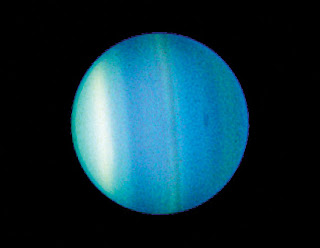Dark,
cold and whipped by supersonic winds, Neptune is the last of the hydrogen and
helium gas giants in our solar system. More than 30 times as far from the sun
as Earth, the planet takes almost 165 Earth years to orbit our sun. In 2011
Neptune completed its first orbit since its discovery in 1846.
Friday 23 November 2012
Uranus
Uranus is the only giant
planet whose equator is nearly at right angles to its orbit. A collision with
an Earth-sized object may explain Uranus' unique tilt. Nearly a twin in size to
Neptune, Uranus has more methane in its mainly hydrogen and helium atmosphere
than Jupiter or Saturn. Methane gives Uranus its blue tint.
Friday 2 November 2012
Saturn
Adorned with thousands of beautiful ringlets, Saturn is unique among the planets. All four gas giant planets have rings -- made of chunks of ice and rock -- but none are as spectacular or as complicated as Saturn's. Like the other gas giants, Saturn is mostly a massive ball of hydrogen and helium.
Jupiter
Jupiter, the most massive
planet in our solar system -- with dozens of moons and an enormous magnetic
field -- forms a kind of miniature solar system. Jupiter does resemble a star
in composition, but it did not grow big enough to ignite. The planet's swirling
cloud stripes are punctuated by massive storms such as the Great Red Spot, which
has raged for hundreds of years.
Jupiter's appearance is a
tapestry of beautiful colors and atmospheric features. Most visible clouds are
composed of ammonia. Water vapor exists deep below and can sometimes be seen
through clear spots in the clouds. The planet's "stripes" are dark
belts and light zones created by strong east-west winds in Jupiter's upper
atmosphere.
Mars
Mars is a cold desert world. It is half the diameter of Earth and has the same amount of dry land. Like Earth, Mars has seasons, polar ice caps, volcanoes, canyons and weather, but its atmosphere is too thin for liquid water to exist for long on the surface. There are signs of ancient floods on Mars, but evidence for water now exists mainly in icy soil and thin clouds.
Earth's Moon
Our Moon makes Earth a more livable planet by moderating our home planet's wobble on its axis, leading to a relatively stable climate, and creating a rhythm that has guided humans for thousands of years. The Moon was likely formed after a Mars-sized body collided with Earth and the debris formed into the most prominent feature in our night sky.
Earth
Earth is an ocean planet. Our home world's abundance of water -- and life -- makes it unique in our solar system. Other planets, plus a few moons, have ice, atmospheres, seasons and even weather, but only on Earth does the whole complicated mix come together in a way that encourages life -- and lots of it.
Wednesday 31 October 2012
Venus
Venus is a dim world of
intense heat and volcanic activity. Similar in structure and size to Earth,
Venus' thick, toxic atmosphere traps heat in a runaway "greenhouse
effect." The scorched world has temperatures hot enough to melt lead.
Glimpses below the clouds reveal volcanoes and deformed mountains. Venus spins
slowly in the opposite direction of most planets.
Mercury
Sun-scorched Mercury is only slightly larger than Earth's Moon. Like
the Moon, Mercury has very little atmosphere to stop impacts, and it is covered
with craters. Mercury's dayside is super-heated by the sun, but at
night temperatures drop hundreds of degrees below freezing. Ice may even exist
in craters. Mercury's egg-shaped orbit takes it around the sun every 88 days.
The Sun
The sun is a star, a hot ball of glowing gases at
the heart of our solar system. Its
influence extends far beyond the orbits of distant Neptune and Pluto. Without
the sun's intense energy and heat, there would be no life on Earth. And though
it is special to us, there are billions of stars like our sun scattered across
the Milky Way galaxy.
Solar System
What is
the solar
system?
It is our Sun and everything that travels around it. Our solar system is elliptical in shape. That means it is shaped like an egg. The Sun is in the center of the solar system. Our solar system is always in motion. Eight known planets and their moons, along with comets, asteroids, and other space objects orbit the Sun. The Sun is the biggest object in our solar system. It contains more than 99% of the solar system's mass. Astronomers think the solar system is more than 4 billion years old.
It is our Sun and everything that travels around it. Our solar system is elliptical in shape. That means it is shaped like an egg. The Sun is in the center of the solar system. Our solar system is always in motion. Eight known planets and their moons, along with comets, asteroids, and other space objects orbit the Sun. The Sun is the biggest object in our solar system. It contains more than 99% of the solar system's mass. Astronomers think the solar system is more than 4 billion years old.
Subscribe to:
Posts (Atom)









